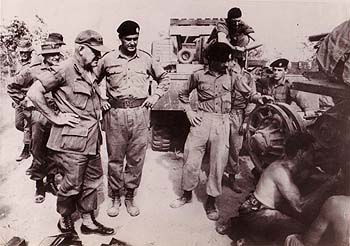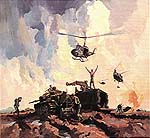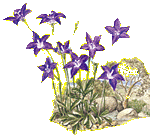Jig and Method for Replacing Centurion Suspension Station

At Puckapunyal, around 1958, I was posted from 1 Armd Regt LAD to Pucka Area Wksp. I saw first hand the repair Centurion Tanks and noted especially the removal and replacement of suspension stations.
This assembly is lifted into position with an overhead lift using an eye cast into the top. The track guards and bins needed to be removed to enable this. I thought there must be an easier way
I am publishing this article not so much for its detail but as an example of deliberatedly developing the methods needed to enable the exchange of heavy assemblies by Forward Repair Teams in the field. Typically three aspects have to be considered
- Some method of accessing the assembly and removing/replacing it with the least amount of removal of non related components
- Some method of providing a surface to work on
- Pre-preparing packs of parts, supplies and tools that travel with the assemblies to the casualty sites
Fitting Jig
- I made up a rectangle frame of 3-inch angle iron that I boxed, just big enough to sit the suspension station into.
- On the bottom of the frame and in the centre, I welded a plate into which I welded a single post, ¾ inch solid round about 6 inches in length. This fitted into the jack lifting plate receptacle of a 5-ton jack.
- I welded legs on the frame so you could wheel the jack under and fit the jack to the spigot. It looked like a low-slung table.
- Using the lifting point on the station it was then placed on the frame. The jack was pumped up just clear of the floor and with the aid of one person was wheeled into position. Jacked up and bolts fitted.
Work Platform
On arrival at 106 Field Workshop in 1968 I saw that the track guards and bins first were being removed first when exchanging suspension stations; a time consuming practice. I made up another frame, as above, which improved the situation in the shop.
However,in the bush, on muddy or dusty uneven ground, pushing a jack with a frame and a heavy suspension station on it was virtually impossible.
The answer was to fit a sheet of 6ftx4ftx¼in steel plate to be carried permanently in the base of the Fitters Track. This not only provided a useful work platform for other types of repair but buffered the Fitters Track from mines damage.
Tools and Repair Parts and Supplies
A Suspension Station, along with Suspension Spring, came on a pallet.
I designed a box to be added to this to hold all the necessary spares and repair equipment and tools needed for the removal a damaged station and fitment of a replacement. I included.
- “D” shackle that fitted the station lifting eye and was big enough to take a sling.
- Replacement studs along with their spring washers.
- Ratchet and socket that fitted the studs.
- A short length of 1 ½ inch “D” pipe that was about 1-½ feet long to place over the end of the ratchet to remove or tighten up the studs.
- 1 intermediate tap to clean out stud holes.
- 1 bottoming tap to do just that.
- 1 tap wrench.
- 1x36inch pipe wrench. (If you had to cut off the stud heads with the oxy, when the station was removed you could use the wrench to remove the remains of the shaft of the studs.)
- 1 wire brush to clean the tank hull where you were going to put the station on.
- 1 Locating pilot steel rod. (A piece of 9 inch steel rod with a tapered end to help locate the holes that you were going to put a stud into.)
- 1 piece of hard board, 3ft x 10 inch x ¾ thick that was use to drag the suspension spring into position.
- 1x 10ft length of 1 ½ inch circumference rope to put around the coil of the spring and thus help pull the spring into position.
- 1 Gal. of Kero for cleaning along with a cleaning dish, usually a 1 gal. Drum that has the side taken out of it.
- 1 cleaning brush along with cleaning rags.
- 1 Frame to carry the suspension station.
- 1x 5-ton jack.
For those may wonder why the GE Platoon did the Centurion Idler, Final Drives and the Suspension Station replacements in the workshop and in the field, it was because the GE Platoon developed the expertise needed.

One of the first outings for the field jig and pack was to FSB Julia in Feb 1969.


